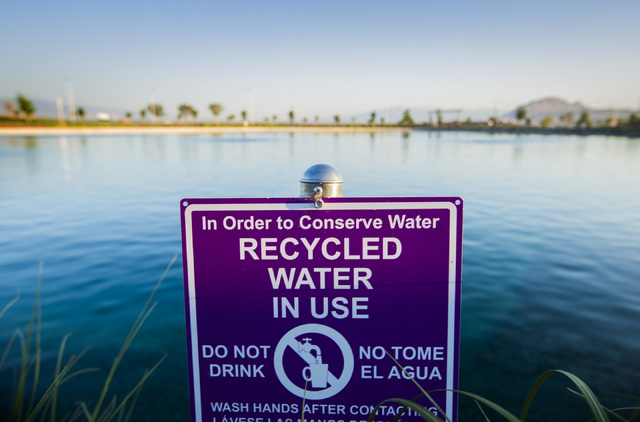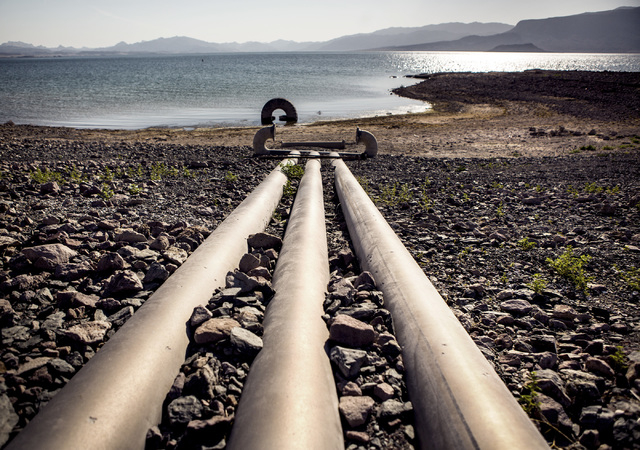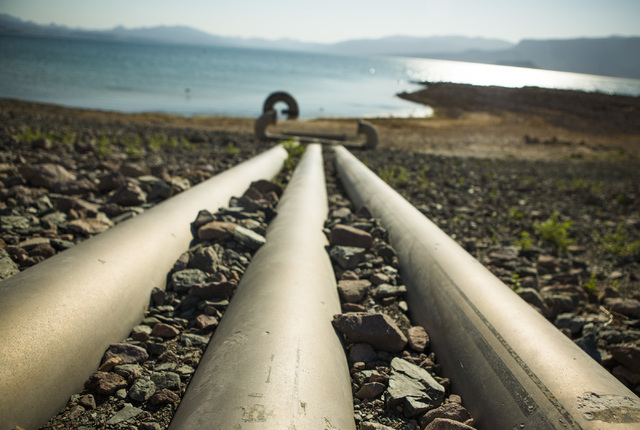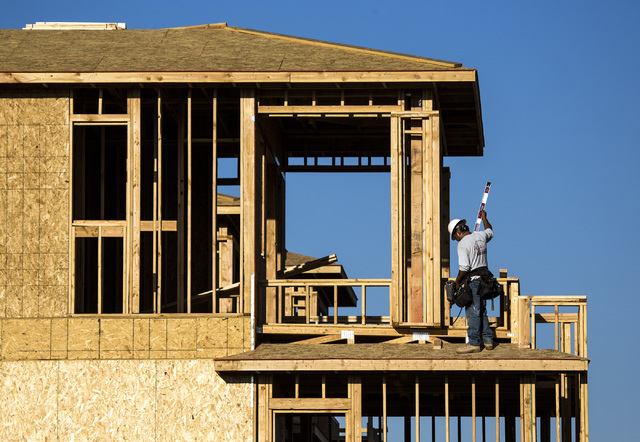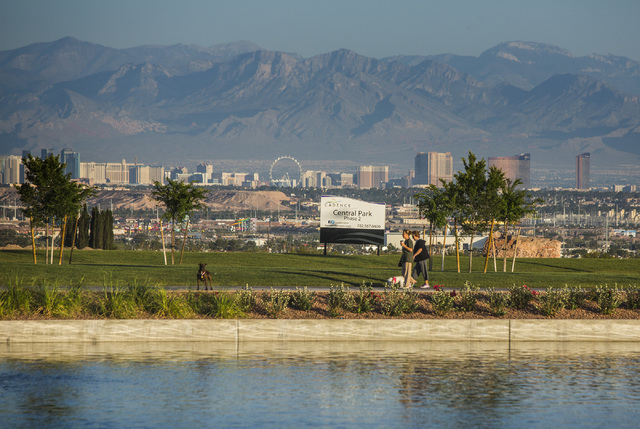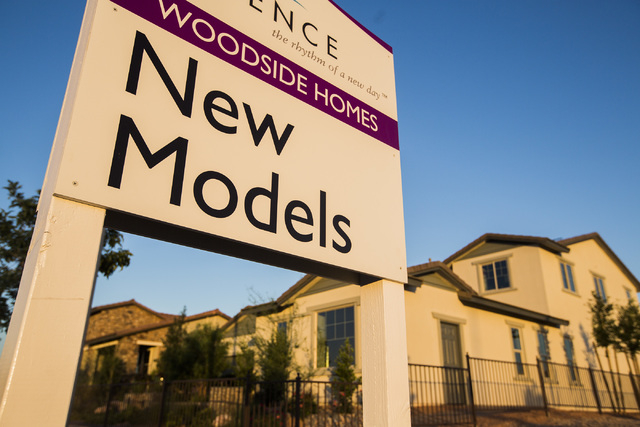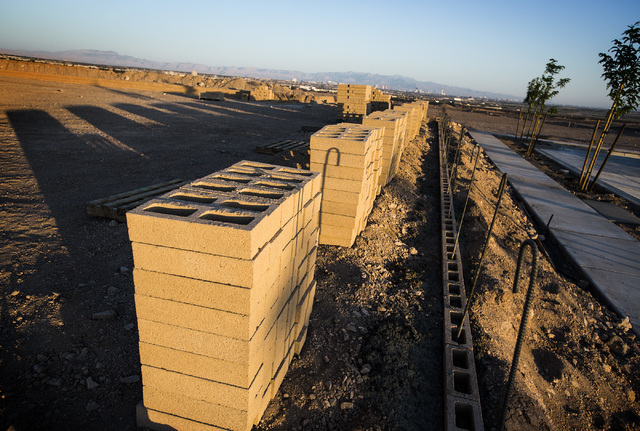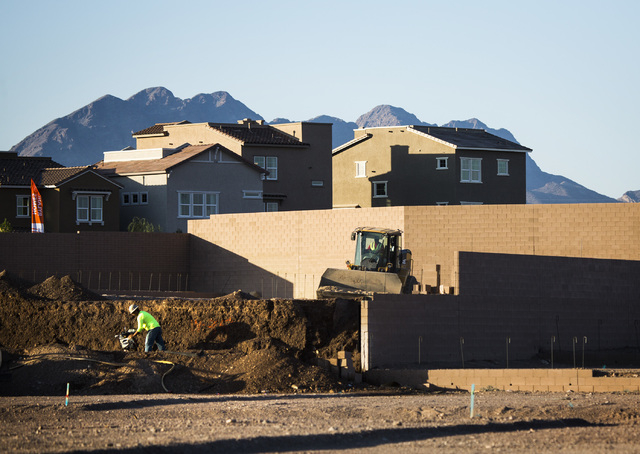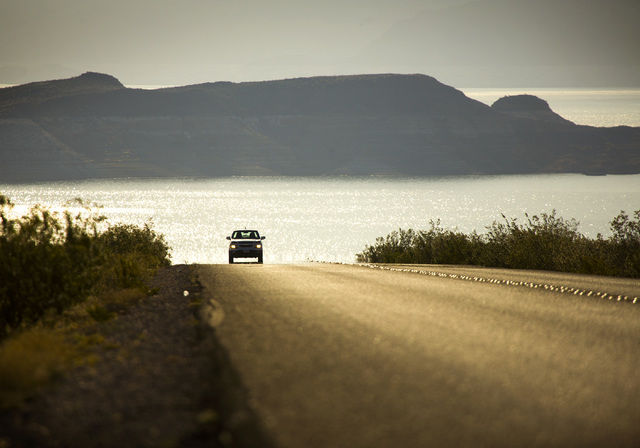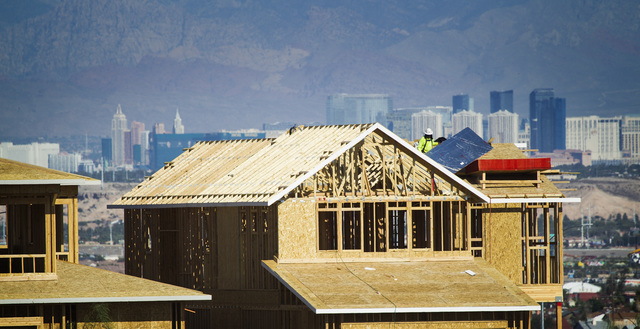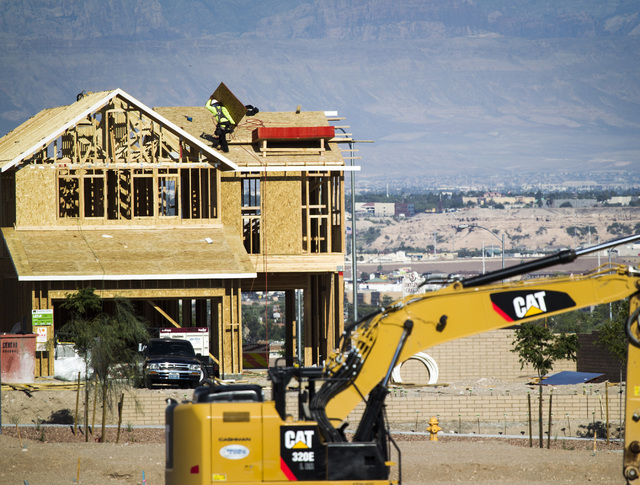Water isn’t a worry when it comes to Las Vegas growth
Forget everything you’ve heard about Southern Nevada’s water crisis.
That includes:
■ Lake Mead will go dry within a decade.
■ The Las Vegas Valley uses more Colorado River water than it has rights to.
■ Resorts and homebuilders are irresponsibly throwing up water-guzzling homes and hotels.
■ The city will run out of water completely and cease to exist in — fill in the blank — five, 10, 15, 30 years.
None of it is true.
Fact is, Nevada has enough water not only for today, but for tomorrow — even a tomorrow that includes hundreds of thousands of new Las Vegans and millions more tourists.
Some of you simply won’t want to hear this message. It defies a rarely questioned groupthink, with media outlets from the West Coast to Europe asserting that Las Vegas is on the brink of dust in the taps.
England’s Daily Mail reported in July that population growth in Las Vegas has “drained 4 trillion gallons of water” — about half of capacity — from Lake Mead, and the city’s “glittering nightlife is in danger of grinding to a halt.”
An environmental reporter with Slate said he spent “only a few minutes” looking at Lake Mead’s “white bathtub ring” in early 2014 before pronouncing Las Vegas a “patient on life support,” and asserting new-home subdivisions “simply should not be.”
USA Today in June 2014 listed Nevada among its “seven states running out of water.”
Even the Las Vegas Sun has an online clock breathlessly counting down the 2,058 days until “Las Vegas runs out of water” — a number the paper presumably took from a 2008 study, later revised, that gave Lake Mead 50-50 odds of drying out by 2021.
The coverage downplays or discounts measures that have kept Southern Nevada in water as the population doubled and Colorado River share went unchanged.
One example: The fact that the valley recycles all indoor wastewater is treated as suspect water-accounting sleight of hand, or ignored altogether.
To be frank, there’s no real defense for Las Vegas. The city shouldn’t be here, smack in the middle of a desert.
But if you gauge a place’s right to exist based on its effect on the Colorado River, then Nevada — at a tiny fraction of the effect of California and Arizona — has greater claim than anyone else. That means Phoenix and most of metro Los Angeles have less right to exist.
Local water officials are the first to acknowledge the Colorado River was divided up during an unusually wet period that’s not likely to happen again. But they also say they can adjust. They say Southern Nevada will have water — so much so that, with continued emphasis on conservation strategies started 15 years ago, thousands more homes can be built in Las Vegas with little additional effect on Lake Mead.
The water is there, so whether Las Vegas should expand is actually a philosophical question of what we and others want the city to be. It’s “should we grow?” rather than “we can’t grow.”
Population growth in the works
On the surface, it’s easy to understand water alarmism.
The footprint of the city is expanding even with potential water cuts coming.
Resorts World Las Vegas is underway with as many as 6,000 rooms. More than half a dozen master plans from Cadence in Henderson to Skye Canyon in the northwest have as many as 70,000 homes planned in the next 20 years. That would boost by 15 percent the number of single-family households, now at 470,000, that rely on lake water.
New locals and tourists are coming. Clark County will surge from 2.1 million to 2.7 million residents by 2035, and 3.2 million by 2050, according to UNLV’s Center for Business and Economic Research. Conservative estimates from research firm Applied Analysis show visitor volumes could jump to 51 million by 2050, up from 41 million now. An aggressive projection says 59 million.
Those forecasts come as Lake Mead, supplier of 90 percent of the valley’s water, slips into critical condition.
Fifteen years of drought have pushed the lake to 38 percent of capacity. The U.S. Bureau of Reclamation in May said it could declare a shortage as early as January 2017 to cut Nevada’s take.
Water scientists warn of additional shortages.
David Pierce, a climate researcher with the Scripps Institution of Oceanography in San Diego, said water in Lake Mead could drop another 10 percent midway through the century. Warmer temperatures will mean more evaporation of lake water, and smaller winter snowpacks will create less runoff to feed the reservoir.
Already, the Colorado River has experienced 12 below-average snowmelt years since 2000, and it is expected to see half of the normal amount in 2015. Lake Mead hit a record-low water level of 1,080 feet above sea level in April, and has dropped another 5 feet since.
A 10 percent drop “is not that big in and of itself, but it’s a problem when you talk about population growth,” Pierce said.
“What determines what Las Vegas gets is a political agreement (the Colorado River Compact of 1922). The problem is, more has been promised than has been available. Climate change is going to make that worse. All of these things are conspiring to give us really significant problems,” he said.
Builders are just as concerned.
Nat Hodgson, executive director of the Southern Nevada Home Builders Association, routinely hears from developers asking if the water situation is stable enough to build. If it’s not, they won’t take the risk, he said.
So far, they see little risk.
That’s because they can do math.
Reusing lake water
Local water agencies treat and return to the lake all indoor wastewater, for which they get return-flow credits. That practice essentially cancels out the effects of indoor use on the lake’s water level. Add all the new homes and resorts you want: Nearly all of their indoor water consumption will be returned to the lake and used again.
Just as important, homebuilders and the Southern Nevada Water Authority agreed in 2001 to strict standards for new homes.
Front-yard grass was banned. Turf out back was limited to 50 percent. Low-flow faucets and toilets were mandated or encouraged through rebates. Hodgson estimates homes built today use 70 percent less water inside and out than homes built before 2000.
Owners of existing homes get rebates for pool covers to prevent evaporation, and for new irrigation clocks and conversions of turf to desert-friendly landscaping.
About 70 percent of local water consumption goes to outdoor use, so the changes have made a big difference.
“Our community in the last 15 years has really begun to adopt a culture of living in the desert,” said John Entsminger, general manager of the Southern Nevada Water Authority.
Those conservation efforts are how the valley has grown from 1.6 million to 2 million residents since 2000 while slashing aggregate water use by 33 percent, Entsminger said.
That trend — more people without substantially more water consumption — will continue as the city builds out, he said. But if you have two homes, and you build two more, you double water use, right?
Not even remotely the case.
“We’re getting to where single-family housing construction has a lot of the characteristics of high-rise construction in terms of outdoor use,” Entsminger said.
Between indoor recycling and outdoor conservation, “you could add millions more people, and the water footprint would be fairly minimal,” he said.
That footprint is also below 1922 allotments. Nevada’s share, which goes entirely to the valley, is 300,000 acre-feet a year, or 1.8 percent of water distributed from the Colorado River. The valley uses 225,000 acre-feet after indoor wastewater is put back. That means even if drought pares the allotment to a mandated 287,000 acre-feet, consumers wouldn’t feel the pinch. The cut would only eat into unused acre-feet the authority banks for later.
“It’s counterintuitive, but Las Vegas is probably the most secure municipal area in the region from a water-resource standpoint,” Entsminger said.
Michael Cohen, a senior associate with Pacific Institute, a California-based nonprofit organization that helps public agencies find solutions to water shortages and other environmental concerns, agreed the water authority has found a formula for both growth and conservation.
“If Las Vegas were using water at the rate it did 20 years ago, there would be rationing now. The leadership has been in front of getting use down, and they’ve created a good model for moving forward. Use trends suggest that smart growth is something that can be accomplished,” Cohen said.
As long as turf restrictions stay and development is dense, the water authority’s belief that the city can grow for the next two decades without stressing supply “is certainly plausible,” he said, adding that water “does not have to be a limiting factor in growth.”
So why the widespread narrative that Las Vegas is running out of water and must stop growing? Are those media outlets wrong?
Well, yes.
People who don’t live here may not be familiar with the decadeslong effort to recycle and save, said Steve Brown, director of UNLV’s Center for Business and Economic Research.
Nor do they make allowances for Southern Nevada’s unusual consumption patterns, Entsminger said.
Take the gallon per capita per day measure. National media quote a figure of about 200 gallons per Las Vegan each day. In Los Angeles, it’s about 130 gallons. In San Francisco, it’s 49. In Tucson, Ariz., it’s 90.
If you account for recycled indoor water, though, Las Vegas consumes 118 gallons per person each day, the water authority said. Also, every other city in America gets far more rain than Southern Nevada’s 4 inches per year. Tucson, for example, gets three times the rain, which means it needs less water for outdoor use.
Nor does dividing use by resident population account for the 41 million tourists who visit each year.
But there’s perhaps a simpler reason the international media love a good bad-water story about Las Vegas.
Sexy headlines.
“The looming catastrophe is what sells, sometimes,” Entsminger said.
The city may not be on the edge of catastrophe, but the Colorado River Basin and the states that rely on it are definitely struggling with low water flow. Everyone is trying to forecast how bad it could get, and plan accordingly.
Nature’s effect
Studies are mixed on how climate change might affect the basin.
The U.S. Environmental Protection Agency has maps showing pockets of decreasing drought in parts of the basin, including in Southern Nevada and southwestern Arizona.
But there also are studies such as the Scripps analysis, which show more evaporation and less water as temperatures rise.
Worse still, water levels could be more variable, making planning tougher, Pierce said.
“Imagine if you started to get strings of dry versus wet years. Even if the average amount didn’t change over 20 years, you might run out in specific years. It’s putting another stress on the system,” he said.
Recent years show the potential for variability.
Nevada faced drought-related allotment reductions in 2009 and 2010, but record snowpack and rain in the Rockies in 2011 and 2012 canceled the cuts. Today, even as cuts are back on the table, Scripps’ worst-case outlook — Lake Mead going dry — isn’t “realistic,” Entsminger said.
“Hoover Dam is there (impounding water). For that scenario to happen, it would mean the Colorado River is dry from the Rocky Mountains to the Grand Canyon to the Pacific Ocean,” he said.
Cohen agreed.
“Some climate-change projections are pretty dire, but I can’t imagine Lake Mead is going to dry up,” he said. “You’d have to have no precipitation in the Upper Basin (above Glen Canyon Dam). There’s a pretty strong chance Colorado River runoff (snowmelt) will go down 15 percent or more, but that still means 12 million acre-feet of runoff a year, which is still a lot of water. In the next 20 years, there will likely be regular shortages on the river, and Nevada and Arizona will suffer. But the volume of Nevada’s shortage is less than what the state is not using now.”
Entsminger acknowledges those 1922 allotments were based on an especially wet era that may never repeat.
But don’t expect consumption to stay the same, either — not even in Nevada.
Creative conservation
Assumptions about the fate of the Colorado River ride on current use, and often ignore the possibility that people in the seven states that use the water will change habits.
In reality, everyone wants to get by on less.
“There’s room for additional creativity. There are more efforts to keep water in Lake Mead,” Cohen said. “Farms and cities are becoming more efficient. Both sectors have a long way to go, which means there’s a lot of potential. There’s quite a bit of water in the system. It just has to be used more efficiently.”
The Southern Nevada Water Authority’s grass-conversion program has reached only half of the turf it can reasonably get, Entsminger said, so the agency is looking to “rejuvenate that program and put some more push behind it.”
The agency’s conservation efforts have driven use per capita per day down by seven gallons in the past year alone, he said.
Other states will “absolutely have to” look at similar initiatives, he said.
In California, which at 4.4 million acre-feet per year guzzles more than 10 times Nevada’s share of the river, Gov. Jerry Brown in April ordered a 25 percent cut in city water use. Use in California fell 13.5 percent in the month from 2013 levels, water regulators said on June 2. Municipalities are finally installing the first water meters ever on hundreds of thousands of homes.
And Mexico agreed in 2012 to leave a portion of its river share in Lake Mead in exchange for private U.S. investments in that country’s water system. The pact has made the Colorado River Basin “more resilient,” Pierce said. It also gave Nevada a one-time boost of 23,700 acre-feet in savings from water efficiencies in Mexico.
If things get really bleak, the water authority has banked 1.5 million acre-feet of unused water — seven to eight years of supply — for an emergency.
But because of demands on a dwindling river, the agency is updating a 50-year plan that calls in other resources, including some at steep prices.
Some answers are already in place. The authority negotiated in 2006 with other states to move as many as 50,000 acre-feet a year from the Muddy and Virgin rivers into the valley’s water system.
Big projects will be needed to pull it all off.
The authority aims to build a 250-mile pipeline north, into rural Nevada, to claim groundwater from the Spring Valley. It’s not on the authority’s hot list right now, which is a good thing: It’s entangled in lawsuits over how much water the authority can pump without hurting rural communities, and whether it properly managed ranches it bought for their water rights.
Entsminger said he believes the authority will ultimately get permits to build the project.
Cohen said it isn’t wise to count on it.
“I think it’s pretty contentious, and not at all clear that it’s going to go through. It’s been litigated for many years, and it’s still a little speculative to rely on that.”
Authority officials are also discussing desalination plants with agencies in Southern California.
Such projects are pricey. It’s not clear how much a desalination plant would cost a few decades from now when it’s needed, but one facility under construction near San Diego is costing $1 billion. The San Jose (Calif.) Mercury-News has reported that the average San Diego water customer’s monthly bill will go from $71 now to as much as $78 once the plant is operating.
The water authority’s Spring Valley pipeline would cost $15 billion, including financing.
As for how that infrastructure might affect water rates, consider how the authority is paying for current projects. A $650 million pumping station about to start construction at Lake Mead will be covered by ratepayers through a fixed charge that will reach $4.81 per month in 2018 and beyond. That’s on a current average monthly bill of $47.13.
The authority in 2013 also raised rates to pay down $3 billion in construction debt on a second water treatment plant; a second intake pipe and pump station at Lake Mead; water-transmission lines; and a third intake pipeline that will let the valley take water even if lake levels dip so low Hoover Dam would have to shut down.
The higher rates are being phased in through 2017 and will depend on use. A residential user with an average monthly bill of $107 will see about an 8 percent increase, to $116. Bellagio’s bill will jump 4.4 percent, from $158,369 to $165,400. Half of the increase is based on consumption, so charges could drop if consumers save.
Despite increases, local water rates remain “competitive” with other Western cities, the water authority said.
Water will definitely get more expensive, Cohen said. But even at their worst, the bills likely won’t approach the expense of air conditioning in Mojave summers, he added.
Besides, there’s a whole other set of costs to stopping development.
Construction goes on
Both Entsminger and Hodgson of the homebuilders’ association said they’d accept a necessary building moratorium like the yearlong stoppage the authority imposed in 1991.
But, they said, it’s just not needed.
“We have enough water to support future growth, even with cuts that are anticipated if Lake Mead continues to decline,” Entsminger said. “So whether we should stop growing is really a philosophical question. It’s the water authority’s job to provide the tools to let the community be what it wants to be through its zoning, business licensing and investment decisions. If the community doesn’t want growth, that’s a community decision. It’s not in our purview to stop issuing water commitments when we have sufficient water resources.”
Embracing an end to growth would be a mistake, UNLV’s Brown said.
The United States is seeing a 60-year shift in population from Northeast and Midwest to South and Southwest, Brown said. People won’t stop moving here.
Without new housing stock, real estate prices would spike from higher demand, Brown said. That’s what has happened in pockets of coastal California, where building is restricted and median home values approach $500,000 or more.
No one’s saying homes here would ever be that expensive. Still, any noticeable price gain could mean trouble for housing affordability in a service-based town with a shortage of high-paying tech jobs and other skilled positions. Eventually, poor affordability “could create a situation in which it’s difficult for the resort industry to maintain or hold down its costs,” he said.
“I would say that as long as growth doesn’t really harm the quality of life here, we should continue to have it,” Brown said. “But whether we do continue to have it depends on our vision — whether we want to be like Northern California, or whether we want to be more free market-oriented. Nevada has both traditions.”
Contact Jennifer Robison at jrobison@reviewjournal.com. Follow @J_Robison1 on Twitter. Review-Journal reporter Henry Brean contributed to this story. Find him on Twitter: @RefriedBrean
Related:
Return flows deserve all credit for Las Vegas’ water supply
Water Allocation:
A mostly unpopulated Nevada drew the shortest straw when the Colorado River’s water was divided among seven states in the 20th century. Up for grabs were 15 million acre-feet of water per year. Here’s how the states rank, from largest to smallest share:
State Acre-feet Percentage per year of flow
California 4.4 million 29.3%
Colorado 3.86 million 25.7%
Arizona 2.85 million 19.0%
Utah 1.71 million 11.4%
Wyoming 1.04 million 6.9%
New Mexico 840,000 5.6%
Nevada 300,000 2.0%
Source: U.S. Bureau of Reclamation



